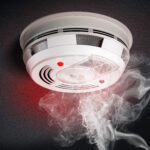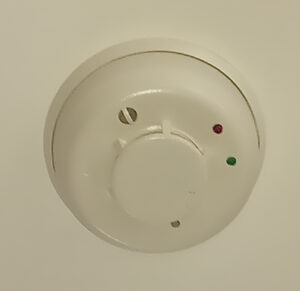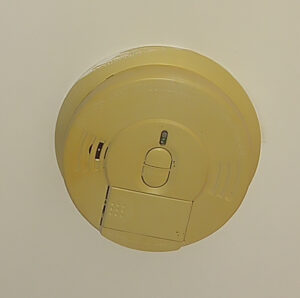 I was sound asleep in my chair. As I started to wake up, I noticed an electrical smell that seemed to come from the television. It had been having problems lately, so I got up, unplugged the TV and went back to my chair only to fall asleep again.
I was sound asleep in my chair. As I started to wake up, I noticed an electrical smell that seemed to come from the television. It had been having problems lately, so I got up, unplugged the TV and went back to my chair only to fall asleep again.
The smell seemed to be getting worse. I woke up and my vision seemed to be playing games with me, there was a haze in my kitchen. By this time I was disoriented but when I saw the billow of brown smoke coming from behind the etagere, adrenaline kicked in. Something was on fire.
I rushed my dogs to the basement and called 911. Then to my horror I discovered it was the HVAC system that had caught fire – I rushed to the basement and put the dogs in the fenced backyard. The 911 Operator told me to evacuate the house immediately. I was so disoriented, she had to tell me at least 3 times.
I went to greet the first responders. Told them about my dogs in the yard. They walked the perimeter of the building and then went inside. The smoke had now filled my home. The source of the fire was condensation from the air conditioning unit dripping on the HVAC blower motor. A minor fire that put itself out, but a major learning opportunity.
A few weeks later, I met with various assistant fire chiefs, battalion chiefs and various firefighters to learn more about their response to a house fire and what they do when they arrive onsite. The list was vast and all of it was to assure the safety of the firefighters, save human lives and extinguish the fire. I attended a live burn exercise to gain a better understanding of their thought process as they approach a fire. I asked about what they do when pets are home. What about the window stickers put up by pet owners? What can I do to help rescue my pets in a fire? Their answers surprised me (and these are just a few of the things I learned from them!):
- Our pets, while important family members to us, are not the first thing on the agenda when the fire department arrives.
- Pets will hide under furniture and in some cases, the dogs know where “out” is and will sometimes greet firefighters at the door. Firefighters cannot and should not risk their lives to save our pets.
- Pets run when they perceive danger, so microchipping your pet is critical. If they are found by someone, the local vet or shelter will scan them and help them find their way back to you.
- Be neighborly. Talk with your neighbors and let them know where your pets are lodged when you are not home. Good neighbors can help provide critical information to first responders.
- The window clings that are marketed to pet owners are largely ignored by firefighters. Years ago there were similar clings to place on the window of a child’s bedroom so first responders could rescue the child. Unfortunately, those clings were left on the windows after the first homeowner moved, and lives were put at risk because of those clings – firefighters looking for a child that wasn’t there. Pet rescue clings are too small, too dark or transparent to be seen from the street. Additionally, putting your phone number on these clings may put you and your family at risk of criminal activity. Perpetrators will call that number pretending to be the Fire Department or the Police Department to acquire the location of your key or entry passcode.
Sadly, CPS has concluded that the majority of “free” pet rescue clings are used to collect your contact information for marketing purposes by animal groups, home monitoring services, and various fire protection-related companies and give a false sense of security to pet owners. Others are sold through various retail outlets as for-profit ventures.
CPS recommends that pet owners do not use pet rescue window clings.
Additional Lessons Learned:
- Ensure your home maintenance is up to date. I postponed my HVAC service appointment a few months before this event. The service technician concluded that the drain line was clogged and allowed condensation to drip on the blower motor. This incident could have been prevented.
- Replace your smoke detectors when they become yellow – and test them monthly. Mine were so old, they never sounded – even though they were a direct wire and the batteries were recently changed. Over time, these become unsightly so that you replace them. (My neighbor suggested painting them – don’t do that.)

New Smoke Detector

Old Smoke Detector
- Consider obtaining a subscription to a monitored alarm service. They are your eyes and ears when you’re not home.
- Build a basic evacuation kit and store one close to each door. I used a water resistant neon-colored pouch, added copies of my dog’s vaccination certificates, pictures of me with my dogs, and a quick-loop leash for each dog. This was valuable when one of the monitored alarms malfunctioned and we needed to evacuate. I looped the leashes around my dog’s necks and waited on the driveway for the firefighters to arrive.
- And most importantly, get out of the building as soon as you can if you suspect a fire. Better safe than sorry.
L.

Comments are closed.